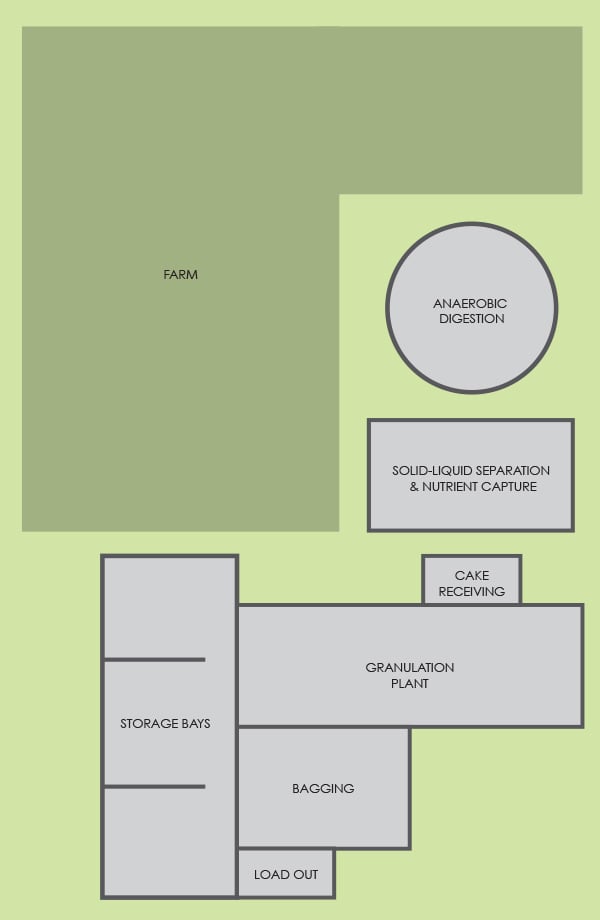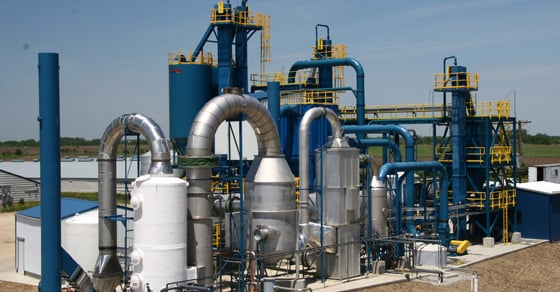The granulation of manure, or other organic waste, into a fertilizer product is a complex process. In addition to developing a pre-treatment and granulation process around the unique source of manure to produce the desired end product, there are many additional considerations that will need to be examined during the development stages. While not an exhaustive list, the list below offers some of the most predominant considerations.
Return on Investment
Return on investment is often the first consideration examined when looking to develop an organics granulation operation. In general, the payback period becomes shorter as the quantity of manure processed increases. This is because the larger the amount of feedstock, the more product that can be produced to either subsidize on-farm fertilizer costs, or to serve as an additional source of revenue to recuperate the initial investment. Furthermore, the labor costs will likely be the same whether the operation is producing 1 TPH or 10 TPH and the incremental capital costs are lower at the larger size plants. For example, to double the production capacity of a plant, the capital cost will typically go up by around 40-50%, allowing the process to produce twice the amount of saleable product for about 1.5 times the capital.
Emissions
While all organics granulation operations produce emissions and will require some form of exhaust gas treatment, the unique source of manure, in combination with local and state regulations will determine how much exhaust gas treatment will be required.
A typical treatment system will consist of a cyclone or baghouse for particulate capture. When volatiles are present in the off gas, additional treatment may be required. This is often handled by adding a wet scrubber and/or thermal oxidizer. Scrubbing systems utilize a water solution in the exhaust gas treatment system to catch particulates and other pollutants such as ammonia, so they cannot be released into the atmosphere with the treated exhaust gas. If a scrubbing system is required, the resulting liquid waste will also need to be disposed of in accordance with regulations.
Spatial Needs & Storage Considerations
There are many things to consider in terms of spatial needs and storage for the operation. An organics granulation plant and the necessary supporting systems require a sizeable facility. If the operation will be on-farm, modifications will need to be made to accommodate the new operation.
A typical granulation layout alone might require 100’ x 100’ x 50’ tall, not including receiving or product storage/baggage, which typically require a significantly larger space than the granulation facility itself. If the feedstock source is nearby and no other minerals will be added, this area is relatively small. However, it can quickly grow to accommodate a more expansive receiving operation, or the addition of additives to the feedstock.
Space will also need to be made for the pre-treatment (nutrient separation, pre-drying, crushing, etc.) part of the process as well. While this does vary, in general, this part of the process usually requires about half the space that the granulation portion requires.
Designating an area for some cake storage is beneficial as well, because it can act as a buffer, in the event that something goes down for a period of time.
In addition to these storage areas, storage space will need to be available in the event that the pre-treatment or granulation plant goes down.
Although highly simplified, the illustration below offers an example of site layout for an on-farm granulation facility.

Fuel Source
The fuel source should also be considered. Most often, natural gas is used, because it is readily available and cost effective. However, other options are available as well. Propane, fuel oil, and diesel offer alternative traditional fuel options, while biogas and waste heat from other on-farm operations offer “free” fuel options when available.
For example, many organics granulation operations are after an anaerobic digestion stage used to pre-treat manure. The biogas produced in anaerobic digestion can be captured and used as the primary fuel source, or as a supplementary fuel source.
Similarly, the source of electricity should also be considered. If a reliable source of electricity is not available, alternatives and options such as large-scale generators will need to be considered.
Product Offtake
Product offtake, or how the end product will be handled after granulation, will also need to be considered. Will the product be stored in silos, open bins, or super sacs? How will the product leave the facility; will a loadout system be required? Will the product be taken away in bulk by truck or rail, or will a packaging facility be required? Many options exist depending on the needs of the system.
Material Handling
Material handling is another important consideration in the design of a granulation facility. Material handling equipment ties the whole process together, moving material from one area to the next in seamless fluidity. A variety of material handling equipment is available, from belt conveyors and bucket elevators, to trippers and plows. Special care will need to be taken in selecting the appropriate handling equipment for the cake handling portion of the process, as cake is sticky and difficult to handle. An automation control such as a Programmable Logic Controller (PLC) will also help to bring transparency and automation to the system.
Conclusion
While the development of an organics granulation system is a complex task with a variety of factors that must be taken into consideration, working with a company that is highly experienced in the field will help to guide you through the process and all that it entails.
FEECO has extensive experience with both inorganic granulation systems and organic granulation systems. We offer a variety of services for those looking to transform their manure or organic waste material into a value-added, marketable product, including feasibility testing, process development, and custom equipment manufacturing. For more information on organics granulation, contact us today!



